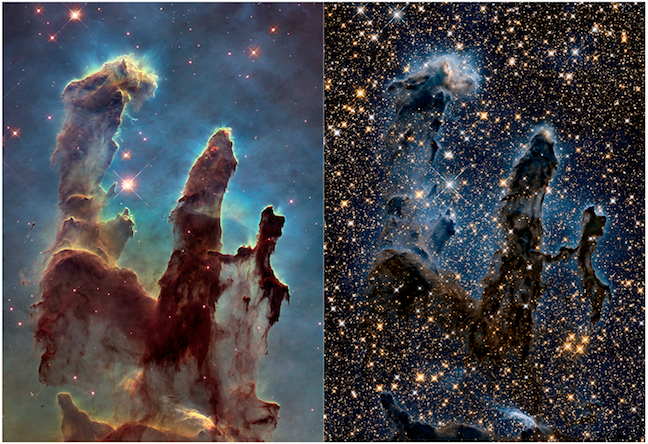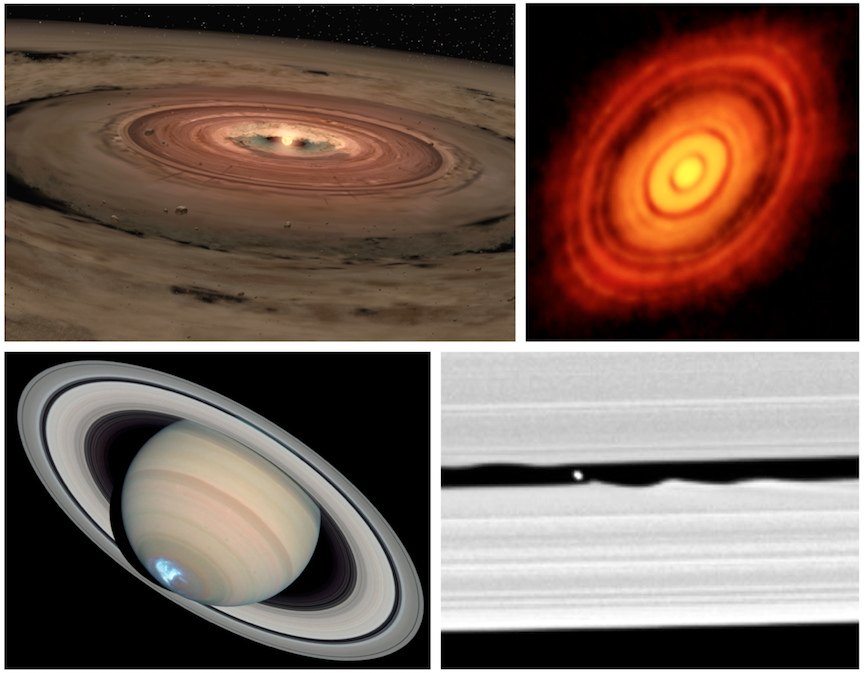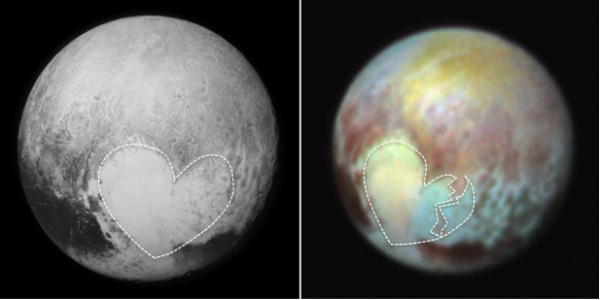2.3 How to Build a Solar System
A solar system consists of a collection of objects orbiting one or more central stars. All solar systems start out the same way. They begin in a cloud of gas and dust called a nebula. Nebulae are some of the most beautiful objects that have been photographed in space. They have vibrant colours from the gases and dust they contain, and brilliant twinkling from the many stars that have formed within them (Figure 2.5). The gas consists largely of hydrogen and helium, and the dust consists of tiny mineral grains, ice crystals, and organic particles.

Step 1: Collapse a Nebula
A solar system begins to form when a small patch within a nebula (small by the standards of the universe, that is) begins to collapse upon itself. Exactly how this starts isn’t clear, although it might be triggered by the violent behaviour of nearby stars as they progress through their life cycles. Energy and matter released by these stars might compress the gas and dust in nearby neighbourhoods within the nebula.
Once it is triggered, the collapse of gas and dust within that patch continues for two reasons. One of those reasons is that gravitational force pulls gas molecules and dust particles together. But early in the process, those particles are very small, so the gravitational force between them isn’t strong. So how do they come together? The answer is that dust first accumulates in loose clumps for the same reason dust bunnies form under the bed: static electricity. Given the role of dust bunnies in the early history of the solar system, one might speculate that an accumulation of dust bunnies poses a substantial risk to one’s home (Figure 2.6). In practice, however, this is rarely the case.

Step 2: Make a Disk with a Star at Its Centre
As the small patch within a nebula condenses, a star begins to form from material drawn into the centre of the patch, and the remaining dust and gas settle into a protoplanetary disk that rotates around the star. The disk is where planets will eventually form. Figure 2.7 (upper left) is an artist’s impression of a protoplanetary disk, and Figure 2.7 (upper right) is an actual protoplanetary disk surrounding the star HL Tauri. Notice the dark rings within the HL Tauri protoplanetary disk. These are gaps formed by the collection of dust and debris by incipient planets, called protoplanets, as they orbit the star. There is an analogy for this in our own solar system, because the dark rings are akin to the gaps in the rings of Saturn (Figure 2.7, lower left), where moons can be found (Figure 2.7, lower right).

Step 3: Build Some Planets
In general, planets can be classified into three categories based on what they are made of (Figure 2.8). Terrestrial planets are those planets like Earth, Mercury, Venus, and Mars that have a core of metal surrounded by rock. Jovian planets (also called gas giants) are those planets like Jupiter and Saturn that consist predominantly of hydrogen and helium. Ice giants are planets such as Uranus and Neptune that consist largely of water ice, methane (CH4) ice, and ammonia (NH3) ice, and have rocky cores. Often, the ice giant planets Uranus and Neptune are grouped with Jupiter and Saturn as gas giants; however, Uranus and Neptune are very different from Jupiter and Saturn.

These three types of planets are not mixed together randomly within our solar system. Instead they occur in a systematic way, with terrestrial planets closest to the sun, followed by the Jovian planets and then the ice giants (Figure 2.9). Smaller solar system objects follow this arrangement as well. The asteroid belt contains bodies of rock and metal. Bodies ranging from metres to hundreds of metres in diameter are classified as asteroids, and smaller bodies are referred to as meteoroids. In contrast, the Kuiper belt (Kuiper rhymes with piper), and the Oort cloud (Oort rhymes with sort), which are at the outer edge of the solar system, contain bodies composed of large amounts of ice in addition to rocky fragments and dust.

Part of the reason for this arrangement is the frost line (also referred to as the snow line). The frost line marks the division between the inner part of the protoplanetary disk closer to the sun, where it was too hot to permit anything but silicate minerals and metal to crystalize, and the outer part of the disk farther from the sun, where it was cool enough to allow ice to form. As a result, the objects that formed in the inner part of the protoplanetary disk consist largely of rock and metal, while the objects that formed in the outer part consist largely of gas and ice. The young sun blasted the solar system with raging solar winds (winds made up of energetic particles), which helped to drive lighter molecules toward the outer part of the protoplanetary disk.
Rules of the Accretion Game
The objects in our solar system formed by accretion. Early in this process, particles collected in fluffy clumps because of static electricity. As the clumps grew larger, gravity became more important and collected clumps into solid masses, and solid masses into larger and larger bodies. If you were one of these bodies in the early solar system, and participating in the “accretion game” with the goal of becoming a planet, you would have to follow some key rules:
- Keep your velocity just right. If you move too fast and collide with another body, you both smash up and have to start again. If you move slowly enough, gravity will keep you from bouncing off each other and you can grow larger.
- Your distance from the Sun will determine how big you can get. If you are closer, there is less material for you to collect than if you are farther away.
- To begin with, you can only collect mineral and rock particles. You have to grow above a certain mass before your gravity is strong enough to hang onto gas molecules, because gas molecules are very light.
- As your mass increases, your gravity becomes stronger and you can grab material from farther away. The bigger you are, the faster you grow.
You would also have to watch out for some dangers:
- In the early stages of the game, the protoplanetary disk is turbulent, and you and other objects can get thrown into different orbits or at each other. This might be a good thing, or it might not, depending on how the rules above apply to you.
- If the game progresses to the point where there is no more material within your reach and you are not yet a planet, then it’s game over.
- If you slow down too much (e.g., from bumping into other objects), you could spiral into the Sun (game over).
- If another planet gets big enough, it can:
- Rip you apart and then swing the pieces around so fast that for the rest of the game you collide too hard with other pieces to grow any bigger (game over)
- Fling you out of the solar system (game over)
- Grab you for itself (game over)
- Trap you in an orbit around it, turning you into a moon (game over, and incredibly humiliating)
Winners and Losers
The outcome of the game is evident in Figure 2.9. Today eight official winners are recognized, with Jupiter taking the grand prize, followed closely by Saturn. Both planets have trophy cases with more than 60 moons each, and each has a moon that is larger than Mercury. Prior to 2006, Pluto was also counted a winner, but in 2006 a controversial decision revoked Pluto’s planet status. The reason was a newly formalized definition of a planet, which stated that an object can only be considered a planet if it is massive enough to have swept its orbit clean of other bodies. Pluto is situated within the icy clutter of the Kuiper belt, so it does not fit this definition.
Pluto’s supporters have argued that Pluto should have been grandfathered in, given that the definition came after Pluto was declared a planet, but to no avail. Pluto has not given up, and on July 13, 2015, it launched an emotional plea with the help of the NASA’s New Horizons probe. New Horizons sent back images of Pluto’s heart (Figure 2.10). On closer inspection, Pluto’s heart was discovered to be broken.

The Accretion Game and the Solar System Today
The rules and dangers of the planet-forming game help to explain many features of our solar system today.
- Proximity to the sun explains why the terrestrial planets are so much smaller than the gas giant and ice giant planets.
- Mars is smaller than it should be, given the rule that distance from the sun determines how much material a body can accumulate, and this can be explained by its proximity to Jupiter. Jupiter’s immense gravity interfered with Mars’ ability to accrete. Further evidence of Jupiter’s interference is the debris field that forms the asteroid belt. From time to time, Jupiter still flings objects from the asteroid belt out into other parts of the solar system, some of which have collided with Earth to catastrophic effect.
- The Kuiper belt is an icy version of the asteroid belt, consisting of fragments left over from the early solar system. The material in the Kuiper belt is scattered because of Neptune’s gravity. From time to time, Jupiter interferes here as well, flinging Kuiper belt objects toward the sun and into orbit. As these objects approach the sun, the sun causes dust and gas to be blasted from their surface, forming tails. We know these objects as comets.
- Comets may also come from the Oort cloud where gravitational forces from outside of the solar system can hurl objects from the Oort cloud toward the sun.

